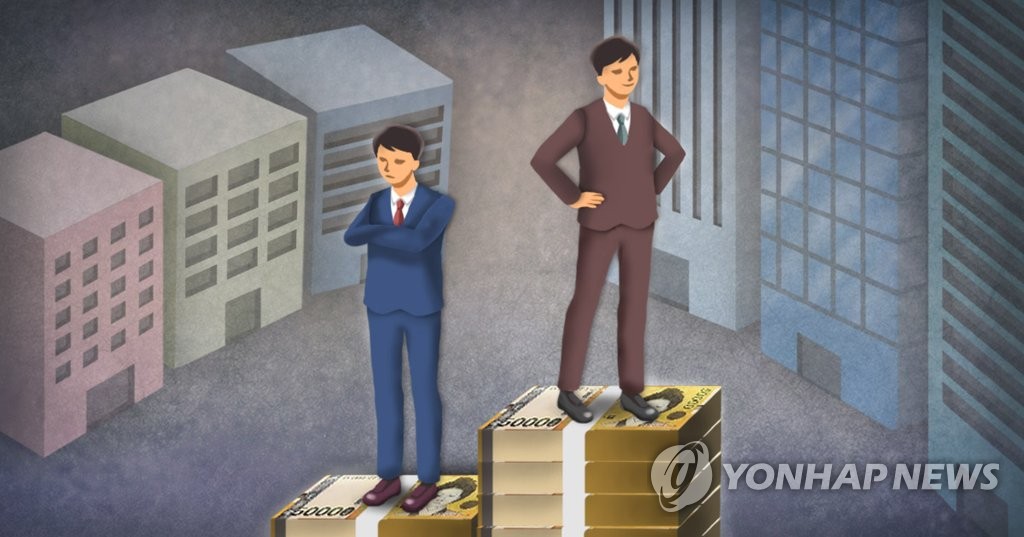Han Kyung-yeon analyzes financial statements of listed companies in 2020… 25% increase in operating profit last year
Clearly focused on corona beneficiary industries and top companies
(Seoul = Yonhap News) Reporter Jang Hana = Even in the phase of the novel coronavirus infection (Corona 19) last year, the operating profit of domestic listed companies increased by 25%, but it was estimated that 1 out of 4 listed companies was difficult enough to earn interest in operating profit.
It is analyzed that the polarization between companies has become clear amid remarkable increases in operating profits of some corona-beneficiary industries such as semiconductors and home appliances and top companies.

[제작 이태호] illustration
As a result of analyzing separate (individual) financial statements of 1,17 KOSPI and KOSDAQ non-financial listed companies by the Korea Economic Research Institute (Kyung-Yeon Han) under the National Federation of Entrepreneurs on the 5th, the sales of domestic listed companies last year amounted to KRW 1,76. 193 trillion won), down 1.5%.
Operating profit recorded 67.3 trillion won, an increase of 24.9% from 53 trillion won in 2019.
Han explained that this is due to the base effect of the sharp decline in operating profit in 2019 and the improvement in the margins of major industries such as semiconductors and home appliances, which enjoyed corona reflection gains.
Han Kyung-yeon analyzed that the K-shaped polarization between companies was particularly evident.
The ratio of average sales between the top 20% and the bottom 20% of listed companies’ sales increased from 266.6 times in 2019 to 304.9 times in 2020. The difference in average operating profit between the top and bottom 20% companies in sales also increased by 28.3% from 238.6 billion won in 2019 to 362 billion won in 2020.
The number of companies with an interest compensation ratio of less than 1, which cannot pay interest on operating profit, has increased by six from 249 in 2019 to 255 in 2020. This is equivalent to 25.1% of listed companies.
The polarization was also evident by industry. Due to the increased demand for corona diagnostic kits, last year’s medical and pharmaceutical industry’s operating profit soared 125.7% compared to 2019. The operating profits of non-face-to-face beneficiaries such as electricity and electronics (64.0%), food and beverage (27.4%), and software, Internet, and broadcasting services (18.6%) also increased significantly compared to 2019.
On the other hand, service sectors such as distribution and face-to-face services (-26.4%), business services (-39.1%), machinery (-72.8%), transportation equipment (-38.7%), steel and metals (-37.8%), and chemicals (-27.1%) %), etc., the operating profit of last year decreased compared to 2019.

[한국경제연구원 제공. 재판매 및 DB 금지]
Last year, the number of publicly traded companies was 1.81 million, down 11,000 from 1091,000 in 2019. The number of employees in the chemical sector decreased by 6,665 (-7.5%) and distribution and face-to-face service by 5,794 (-6.0%).
SW, Internet, broadcasting service (2,129 people), telecommunications (1,106 people), food and beverages (1,12 people), etc., have seen a decrease in the number of employees despite the increase in operating profit.
There were only four industries with an increase in the number of employees: electricity and electronics (4,749 people), transportation equipment (2,946 people), medical pharmaceuticals (1,156 people), and electric gas (265 people).
As a result of an analysis of 7 industries (excluding other industries) whose operating profit increased by more than 10% last year, the proportion of the top three companies in the increase in operating profit by industry showed up to 191.8%.
In the electric and electronic industry, the increase in operating profit of the top three companies accounted for 91.0% of the increase in the total operating profit in the industry. The proportion of the top three companies in transportation/warehouse and non-metals was 191.8% and 175.0%, respectively. Excluding the top three, operating profit was rather reduced.
“The performance of listed companies seems to be good, but many companies still have not escaped from the corona shock,” said Chu Kwang-ho, head of the economic policy department. “In order to enhance corporate vitality, active policy support from the government such as regulatory reform is required.”
Unauthorized reproduction-redistribution prohibited>
2021/04/05 06:00 sent
